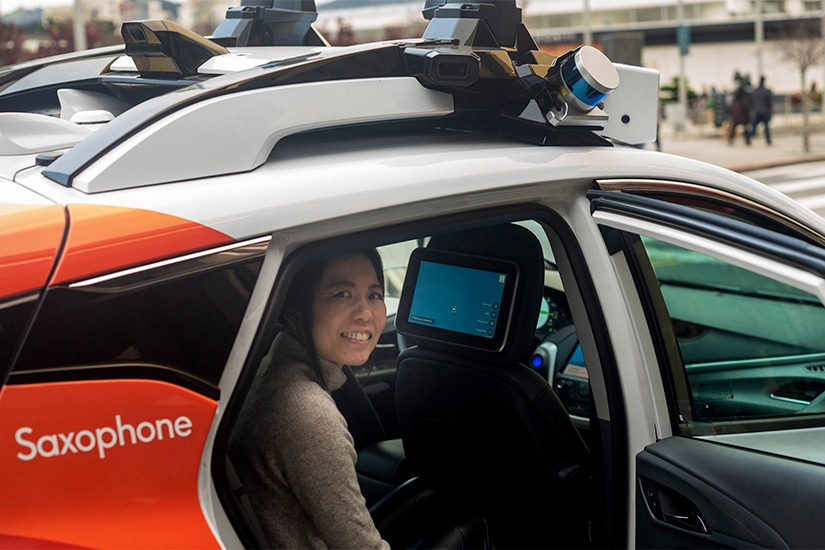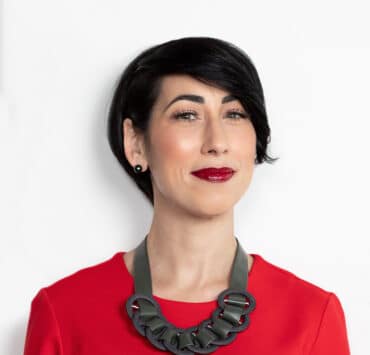|
Getting your Trinity Audio player ready...
|
Olivia Tsai likes to take the company car for a spin. She was actually once Cruise’s top rider, though she says a car like Poppy takes some getting used to. At first glance, Poppy looks like a white Chevrolet Bolt, but it’s no standard electric vehicle. There’s no steering wheel. Or pedals. Or mirrors. Instead, an array of high-tech sensors and cameras help it navigate the busy streets of San Francisco. Poppy isn’t a normal car—it’s a fast-thinking, self-driving autonomous vehicle that’s about to change our roads and cities forever.
It’s a big vision in a crowded space, with companies like Aurora and TuSimple racing against Cruise to be the first to make a splash in the marketplace. As the company’s assistant general counsel and head of intellectual property, Tsai leads a team that is responsible for building their patent and trademark portfolio and securing the IP rights that protect the inventive designs and solutions that Cruise develops. “Innovation is what makes Cruise special,” she says. “A good IP strategy will let that work continue.”

A self-driving fleet of electric cars might sound like science fiction, but Cruise vehicles have already crisscrossed the Bay Area—logging millions of miles with and without passengers. Cars like Poppy use complex sensors to “see” around objects and map precise locations. They’re constantly calculating efficient routes, reacting to changes, and sending data back to their engineers for continuous improvement. Cruise’s leaders say the safe, shared, electric, self-driving vehicles will save time, reduce emissions, and reduce accidents.
Cruise’s engineers have solved complex problems that once plagued the industry. For years, test vehicles in the entire industry struggled with unprotected left turns. But by 2019, Cruise had released a video showing its cars executing 1,400 left turns in one twenty-four-hour period. According to cofounder, president, and chief executive officer Kyle Vogt, “By safely executing 1,400 regularly, we generate enough data for our engineers to analyze and incorporate learnings into code they develop for other difficult maneuvers.” These are the types of innovations Cruise’s engineers work so hard to achieve.
“Innovation is what makes Cruise special. A good IP strategy will let that work continue.”
Olivia Tsai
Vogt studied at MIT before cofounding Twitch, an interactive livestreaming service that was acquired by Amazon for $1.1 billion. He started Cruise in 2013 and attracted parent company General Motors (GM) three years later. When Tsai joined the start-up in 2017—coming from networking giant Cisco—Cruise allowed her and other employees to use its fleet as a ride-sharing network. Today, after investments from GM, Honda, SoftBank, T. Rowe Price, Walmart, and others, the company has 2,500 employees and a valuation of over $30 billion.
“I’ve learned to be flexible and pivot, and those skills help lawyers find success in fast-moving companies.”
Olivia Tsai
Cruise is working to expand its ride-hailing and delivery services. Tsai, a former MIT engineer with fifteen years of experience at tech companies of all sizes, has developed the right skills to help Cruise flourish. She started her career at a firm, preparing patent applications for Fortune 500 companies, before moving to Sandia National Laboratories, where she led IP development and strategy for a robotics division. While at Cisco, she built patent portfolios for divisions including Meraki, protecting the acquired cloud-networking company’s line of products and services.
“I’ve learned to be flexible and pivot, and those skills help lawyers find success in fast-moving companies,” she says. Alongside Cruise’s rapid pace, Tsai has worked tirelessly to implement documentation, policies, and procedures that will help the company scale. She recognizes the value of collaboration and cofounded an IP industry working group, Allied Transportation Association, with Kurt Brasch of Uber. Tsai is also contributing to the organization’s corporate culture; in 2018, she cofounded an Asian and Pacific Islander Employee Resource Group with Dan Kan, Cruise’s cofounder and chief product officer.
Tsai is confident that Cruise will continue to innovate. In 2020, her colleagues introduced the Cruise Origin, a driverless delivery van built for up to six passengers. The following year, California granted Cruise a driverless taxi permit. Vogt was its first passenger. He got in the car (named Sourdough), pressed the “start ride” button, and rode safely to his destination. As he exited, Sourdough pulled into traffic and disappeared into the San Francisco night.
Cruise hasn’t yet announced when it will begin wide-scale deployment of ride-hailing services for the public, but Tsai can’t wait to introduce Poppy, Sourdough, and the entire driverless fleet to her friends.

